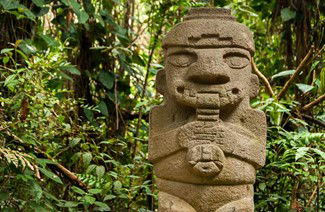San Agustin

The San Agustín Archaeological Park (Spanish: Parque Arqueológico de San Agustín) is an archaeological site located near the town of San Agustín in Huila Department in Colombia. The site contains the largest collection of religious monuments and megalithic sculptures in Latin America and is considered the world's largest necropolis. It was declared a UNESCO World Heritage Site in 1995.
The statues were first described by a Spanish monk, Fray Juan de Santa Gertrudis (1724–1799), who visited the then New Kingdom of Granada in 1756–57 as a missionary. He passed through San Agustín in mid-1756, and wrote about the statues in his four-volume work Maravillas de la naturaleza.
The dates of the statues are uncertain, but they are believed to have been carved between 50–400 A.D. The origin of the carvers remains a mystery, as most of the site is unexcavated, and no writings have been discovered yet.
The statues vary in height, the tallest being 23 feet (7.0 m) tall. They are suspected to be funereal statuary. In other regions of the archaeological site where large burial mounds are located, you will see more intimidating figures such as snakes, frogs, and birds strategically place to stand guard for increased protecting during the afterlife. Statues of deities or carving on the ground, of both solar gods, males, and lunar gods, females. These figures and statues provide researchers with a little insight to what this civilization thoughts and perception of life and death are.
Thanks Wikipedia!


